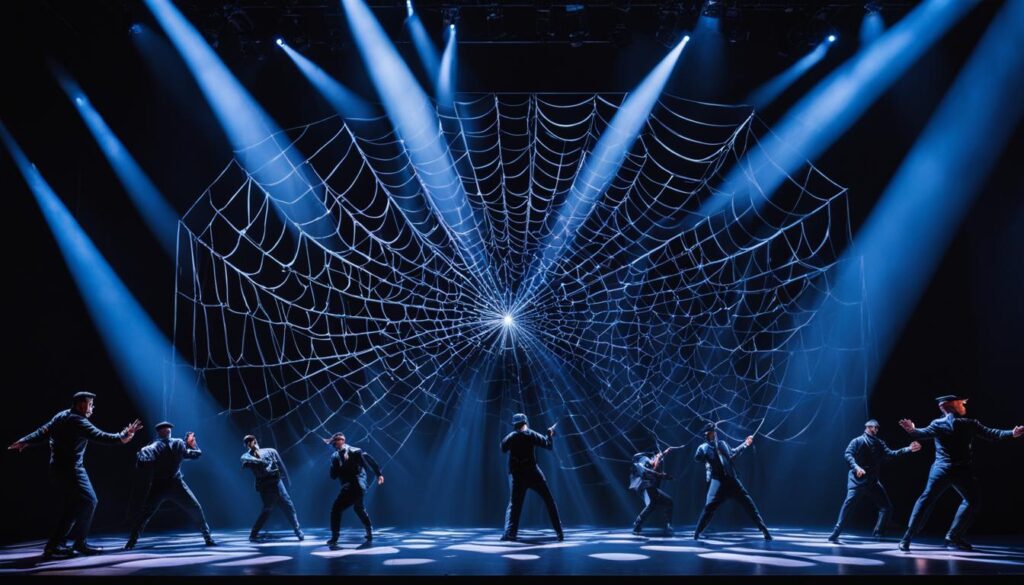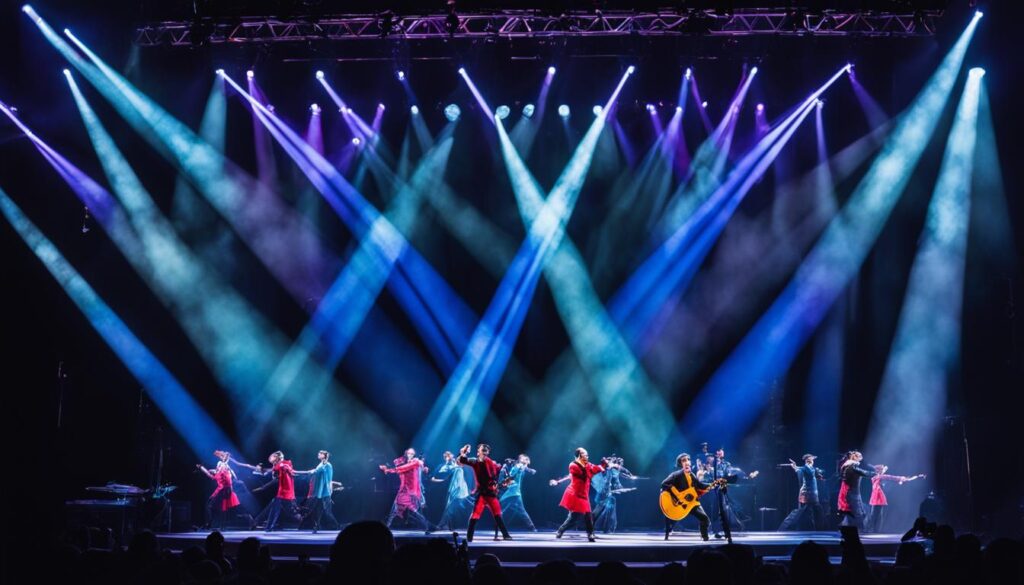Are you a stage lighting technician looking to showcase your skills and expand your client base? Look no further than freelance stage lighting tech marketing. As a freelance lighting tech or stage technician, you bring shows to life with your expertise in lighting design and operation.
Whether you offer lighting design services, stage lighting services, or specialize as an event lighting specialist, it’s essential to market your skills effectively to attract clients and stand out in the industry. By promoting your services as a professional lighting technician or freelance lighting designer, you can provide stage lighting solutions that elevate performances to new heights.
Attracting clients in the entertainment industry can be a challenge, but with the right marketing strategies, you can illuminate your shows and create opportunities for growth. From reaching out to potential clients through online platforms and networking events to showcasing your past work and establishing your expertise, freelance stage lighting tech marketing allows you to connect with the right audience and make a lasting impression.
Ready to shine a light on your freelance stage lighting tech business? Let’s explore the role of a lighting technician and how you can enhance your marketing efforts to capture the attention of clients in search of top-notch lighting professionals.
Understanding the Role of a Lighting Technician
Lighting technicians are invaluable members of the lighting crew who play a multifaceted role in ensuring the success of a show. Their expertise in lighting design, rigging, programming, and equipment maintenance contributes to creating captivating visual experiences for the audience.
As part of their responsibilities, lighting technicians handle various tasks, including loading in equipment, organizing cables, and hanging lights. They meticulously focus the light fixtures to achieve the desired effect and ambiance, enhancing the overall visual environment of the performance.
Rigging: Lighting technicians excel in rigging, a skill that involves safely and securely mounting lights and other equipment to trusses, grids, or other structures. They meticulously analyze the venue and collaborate with the design team to determine the optimal placement and configuration of lighting fixtures.
Programming: Through their proficiency in programming, lighting technicians employ sophisticated light boards to create dynamic and synchronized lighting sequences. They expertly manipulate color, intensity, and movement to enhance specific scenes, ensuring a seamless integration of lighting and performance.
Equipment Maintenance: Lighting technicians have a keen eye for detail and are responsible for meticulously inspecting and maintaining lighting equipment. They diagnose and troubleshoot any technical issues that may arise during rehearsals or a show, ensuring uninterrupted lighting operations.
Collaboration: Lighting technicians collaborate closely with other members of the lighting crew, such as electricians, dimmer technicians, and lighting directors. This teamwork enables them to seamlessly execute the lighting design, with each member contributing their specialized skills to create a cohesive and visually stunning experience.
In addition to their technical expertise, lighting technicians possess problem-solving skills and adaptability, enabling them to navigate any challenges that may arise during a production. Their ability to maintain composure and effectively communicate with team members ensures a smooth and successful show.
| Responsibilities | Description |
|---|---|
| Equipment Loading | Loading in lighting equipment, ensuring proper setup and organization. |
| Cable Management | Organizing cables to ensure efficient and tidy setups. |
| Lights Hanging | Professionally rigging lights according to the lighting design. |
| Focus Adjustment | Focusing light fixtures to achieve desired illumination and effects. |
| Programming | Creating lighting sequences and cues using advanced light boards. |
| Equipment Maintenance | Inspecting, repairing, and maintaining lighting equipment. |
| Collaboration | Working closely with the lighting crew and other production team members. |
The Artistry of Lighting Design
When it comes to creating memorable performances or events, lighting designers hold the key to transforming the visual environment. Through their unique blend of technical expertise and artistic sensibility, they collaborate closely with directors, playwrights, and choreographers to bring their vision to life. Lighting designers understand the importance of supporting the creative vision while enhancing the overall experience for the audience.
In the world of lighting design, artistry and innovation go hand in hand. Designers constantly explore new ways to combine cutting-edge technology with artistic expression, pushing the boundaries of what is visually possible. Their goal is to strike a delicate balance between creating a visually exciting atmosphere and supporting the performances without overshadowing them.
Collaboration is at the heart of lighting design. Working alongside other designers and the director, lighting designers translate the creative vision into a practical light plot. They carefully consider the mood, emotions, and themes of the performance, incorporating lighting techniques that support and enhance them. This collaborative process allows the designer’s artistry to shine while ensuring a cohesive visual experience for the audience.
Here is an example of how lighting design can create a visually captivating environment:

| Lighting Technique | Description |
|---|---|
| Color Wash | A soft wash of colored light that fills the stage, creating a specific mood and ambiance. |
| Spotlight | Narrow, focused light that highlights a specific actor or prop, directing the audience’s attention. |
| Gobo Projection | Using a stencil or template placed in front of the light to project patterns or textures onto the stage, adding depth and visual interest. |
| Backlight | Illumination from behind the performers, creating silhouettes and separating them from the background. |
Creating a Visually Exciting Atmosphere
Lighting designers aim to create a visually exciting atmosphere that supports the performances and engages the audience. They carefully select the right combination of lighting techniques, colors, and intensities to convey the desired mood and highlight the key moments of the show. Each lighting cue is meticulously crafted to enhance the narrative and evoke specific emotions, whether it’s a thrilling chase scene or a tender romantic moment.
The artistry of lighting design lies in the ability to paint with light, using shadows, angles, and color to create a multi-dimensional visual experience. By considering the overall vision of the performance and collaborating with other creative professionals, lighting designers play a pivotal role in bringing the stage to life, captivating audiences, and supporting the storytelling process.
The Role of Electricians in Lighting Production
Electricians are an integral part of the lighting production process, working closely with lighting designers to bring their vision to life. Led by a master electrician, the electrics crew plays a crucial role in implementing the designer’s vision and ensuring a seamless production.
The electrics crew is responsible for setting up and operating the lighting system according to the lighting designer’s specifications. They meticulously hang, patch, focus, and control the lights during the show to create the desired visual effects.
Collaboration between the lighting designer and the electricians is of utmost importance. Together, they work hand in hand to translate the creative vision into practical lighting solutions. This collaborative effort ensures that the design is successfully implemented and meets the artistic requirements of the production.
The master electrician plays a pivotal role in coordinating the electrics crew. They oversee the crew’s activities, manage budgets, and solve any technical problems that may arise. Their expertise and leadership ensure a smooth workflow and the successful execution of the lighting design.
In the fast-paced world of lighting production, electricians are the unsung heroes behind the scenes. Their technical expertise, attention to detail, and collaborative mindset are essential in creating captivating visual experiences for audiences.
| Responsibilities of Electricians in Lighting Production |
|---|
| Setting up and operating the lighting system according to the designer’s specifications |
| Hanging, patching, focusing, and controlling lights during the show |
| Collaborating with lighting designers to implement their vision |
| Coordinating the electrics crew |
| Managing budgets and problem-solving |
Challenges and Collaboration in Lighting Production
Theatre lighting production is a demanding and collaborative process that requires professionals in the industry to navigate various challenges. From working with professional theatre lighting to managing tight deadlines and limited budgets, the journey from concept to execution can be both exhilarating and complex.
One of the key elements in overcoming these challenges is collaboration. Lighting designers and electricians must work closely together to bring the design to life. Each person brings their unique expertise and perspective to the table, contributing to the overall success of the production.
The Importance of Collaboration
Effective communication and teamwork are essential in managing the artistic pressure that comes with creating professional theatre lighting. By collaborating closely, professionals can ensure that every aspect of the lighting plan is executed flawlessly, enhancing the overall experience for the audience.
Collaboration also plays a crucial role in problem-solving. As challenges arise during the production process, the collective expertise of the team can be leveraged to find innovative solutions and keep the project on track. Whether it’s troubleshooting technical issues or adjusting the lighting design to fit the artistic vision, teamwork is the key to success.
Teamwork and Problem-Solving
Working in the field of professional theatre lighting requires individuals to be adaptable and solution-oriented. The ability to think on your feet and find creative solutions is crucial in ensuring a smooth production. Lighting professionals tackle challenges head-on, finding ways to overcome obstacles while staying true to the artistic vision.
Collaboration and problem-solving go hand in hand. When faced with tight deadlines or unexpected constraints, professionals in the industry come together, pooling their skills and knowledge to find the best way forward.
Whether it’s adjusting the lighting design to accommodate last-minute changes or finding innovative ways to maximize the impact of limited resources, the ability to problem-solve as a team is essential. Through effective collaboration, lighting professionals can deliver exceptional results even under challenging circumstances.

Working Together for a Successful Production
Despite any differences in personality or working styles, professionals in the lighting industry understand the importance of working together to achieve the desired results. By collaborating closely, embracing teamwork, and leveraging problem-solving skills, lighting professionals can overcome challenges and create memorable productions.
From the initial concept to the final execution, the collaborative efforts of lighting designers and electricians play a crucial role in bringing the artistic vision to life. Together, they navigate the complexities of professional theatre lighting, ensuring a seamless and visually captivating experience for the audience.
| Challenges | Collaborative Solutions |
|---|---|
| Tight deadlines | Effective communication and teamwork to streamline processes and meet deadlines |
| Limited budgets | Creative problem-solving to maximize the impact of available resources |
| Artistic pressure | Collaborative decision-making and adapting the lighting design to meet artistic expectations |
| Technical challenges | Collaborative troubleshooting and finding innovative solutions |
Advancing the Field of Lighting Design
Lighting design is a dynamic field that constantly evolves, driven by a combination of cutting-edge technology, artistic experimentation, and a painterly approach. Designers in this field are always seeking new methods to enhance the visual experience of performances and create captivating environments that support storytelling.
By embracing cutting-edge technology, lighting designers can explore innovative ways to manipulate light and color, experiment with different types of fixtures, and leverage automation and intelligent systems. This allows them to create mesmerizing visual effects that captivate the audience and enhance the overall experience.
At the same time, lighting designers understand the importance of maintaining a painterly approach to their craft. They draw inspiration from the realm of traditional painting, using light as their brush to create mood, atmosphere, and depth on stage. This artistic approach ensures that lighting design remains a deeply expressive and emotionally resonant art form.
Through artistic experimentation, lighting designers continuously push the boundaries of their craft. They explore novel techniques, challenge conventions, and break new ground in pursuit of innovative artistic expression. By merging different mediums and exploring unconventional approaches, designers create unique visual experiences that captivate audiences and leave a lasting impression.
However, amidst all the technical advancements and artistic exploration, the core purpose of lighting design remains unchanged – storytelling. Lighting designers understand that their primary focus is to support the narrative and guide the audience’s attention to the key elements of the performance.
Whether it’s subtly illuminating a character’s facial expression, using light to create a specific mood, or highlighting significant moments, lighting designers meticulously craft visual cues that enhance the storytelling experience. They understand the importance of audience focus and create lighting designs that draw viewers into the world of the performance, helping them connect with the story on a deeper level.
Advancements in Lighting Technology
The field of lighting design has witnessed significant advancements in technology, revolutionizing the possibilities of expression. Here are some cutting-edge technologies that have transformed the field:
| Technology | Description |
|---|---|
| LED Lighting | LED lights offer versatility, low power consumption, and color customization options, allowing designers to create vivid and dynamic lighting effects. |
| Moving Lights | Moving lights provide the ability to change position, color, and shape dynamically, making them ideal for creating dynamic and engaging lighting designs. |
| Projection Mapping | Projection mapping enables designers to transform static surfaces into dynamic canvases, adding depth, motion, and immersive visuals to performances. |
| Wireless Control Systems | Wireless control systems offer flexibility and convenience, allowing designers to control and synchronize lighting cues seamlessly. |
The Journey to Lighting Design
For many aspiring lighting designers, the path to success begins with hands-on experience in the field. Often starting as staff electricians or freelancers, these individuals collaborate closely with experienced designers and gain valuable knowledge that propels them towards their dream career. Through this journey, aspiring lighting designers acquire the necessary skills and understanding to transition from supporting roles to becoming the creative minds behind dazzling light displays.
Working as a staff electrician or freelance lighting technician provides aspiring designers with the opportunity to learn from industry experts and expand their skill set. By collaborating closely with established professionals, they gain insights into the intricate art of lighting design, from conceptualization to execution. This real-world experience not only deepens their technical expertise but also nurtures their creative instincts.
Throughout their careers, lighting designers continue to learn and grow, adapting to advancements in technology and embracing new artistic possibilities. They stay up-to-date with the latest lighting techniques, software, and equipment to push the boundaries of their craft. By constantly expanding their knowledge base, lighting designers can create immersive experiences that captivate audiences and bring their artistic visions to life.
Overall, the journey to becoming a lighting designer is a continuous process of learning, collaboration, and experience. Whether starting as a staff electrician or a freelance lighting technician, aspiring designers acquire the skills and knowledge needed to succeed in the dynamic world of lighting design.
The Power of Lighting in Performance
Lighting is a fundamental component of any performance, whether it’s a concert, play, dance show, or opera. It serves as the visual glue that enhances other elements and sets the mood for the audience. With the skillful use of illumination, lighting designers have the power to create visually captivating environments that support the overall storytelling of a performance.
Effective lighting design goes beyond mere illumination; it is an art form that can evoke emotions, emphasize key moments, and guide the audience’s attention. Just like a painter uses different colors and brushstrokes to convey a message, lighting designers utilize visual elements to enhance performances and immerse the audience in a world of visual storytelling.
Imagine a dramatic scene in a play where a solitary spotlight shines on the protagonist, highlighting their inner turmoil. The focused beam of light creates a powerful visual effect that draws the audience’s gaze and intensifies the emotional impact of the moment.
Lighting can also create dynamic atmospheres that transport the audience to different settings. Whether it’s the dimly lit streets of a film noir or the vibrant colors of a Broadway musical, the clever use of lighting can transport the audience into the heart of the performance.
Furthermore, lighting design plays a crucial role in enhancing the overall impact of a performance through careful manipulation of visual elements. By strategically highlighting specific areas of the stage or using dynamic lighting effects, designers can direct the audience’s attention to key elements, such as a dancer’s graceful movements or a singer’s powerful vocals.
Case Study: Lighting Design in a Dance Performance
Let’s explore a case study of how lighting design can elevate a dance performance. In a contemporary dance piece, the lighting designer utilizes a combination of spotlights and color washes to create an atmospheric environment that complements the choreography.
The performance begins with a soft, warm wash of light, casting a gentle and dream-like ambiance that matches the delicate movements of the dancers. As the intensity of the choreography increases, the lighting designer introduces dynamic lighting effects, such as strobes and quick changes in color, to heighten the energy and create a sense of excitement among the audience.
During a climactic moment in the performance, a single spotlight isolates a solo dancer, emphasizing their emotional journey and captivating the audience’s attention. The lighting design supports the visual storytelling, enhancing the power of the performance and leaving a lasting impression on the spectators.
In the world of performance, lighting design is more than just illuminating the stage; it is an essential tool for enhancing performances and creating immersive visual experiences for the audience. Through the skillful use of illumination, lighting designers bring visual elements to life, intensify emotions, and guide the audience’s attention. The power of lighting in performance is undeniable, as it transforms a simple stage into a captivating world of visual storytelling.
Conclusion
Freelance Stage Lighting Tech marketing plays a vital role in the entertainment industry, offering services that elevate the visual experience of performances and live events. The collaboration between lighting technicians, designers, and electricians is the driving force behind the success of these events, showcasing the transformative power of lighting in visual storytelling. By harnessing cutting-edge technology, embracing artistic experimentation, and maintaining effective teamwork, lighting professionals bring audiences into a world of captivating illumination.
Through their expertise and creative collaboration, lighting professionals bring out the best in performances, enhancing the mood, atmosphere, and overall impact of the show. Whether it’s a concert, play, dance show, or opera, the strategic use of lighting creates visually captivating environments that support and enhance the narrative. The careful selection of lighting techniques and the seamless integration of visual elements contribute to a truly immersive experience for the audience.
With a focus on visual storytelling, freelance stage lighting tech marketing serves as a bridge between the artistic vision and its execution. Lighting professionals understand the importance of crafting lighting designs that not only enhance the performances but also guide the audience’s attention and evoke emotions. Their ability to create captivating illumination through a combination of technical expertise and artistic expression is what sets them apart as masters of their craft.
As the entertainment industry continues to evolve, freelance stage lighting tech marketing remains at the forefront of innovation. Lighting professionals stay abreast of cutting-edge technology and constantly push the boundaries of artistic experimentation. By combining technical prowess with a keen understanding of storytelling, they deliver awe-inspiring visual experiences that captivate audiences and leave a lasting impression.

Ryan Conlon is a highly experienced Corporate Freelance Lighting Designer with two decades of dedicated work in the entertainment industry. With a passion for creating captivating lighting experiences, Ryan has contributed his expertise to numerous corporate meetings, stage productions, concerts, and events throughout his career.
